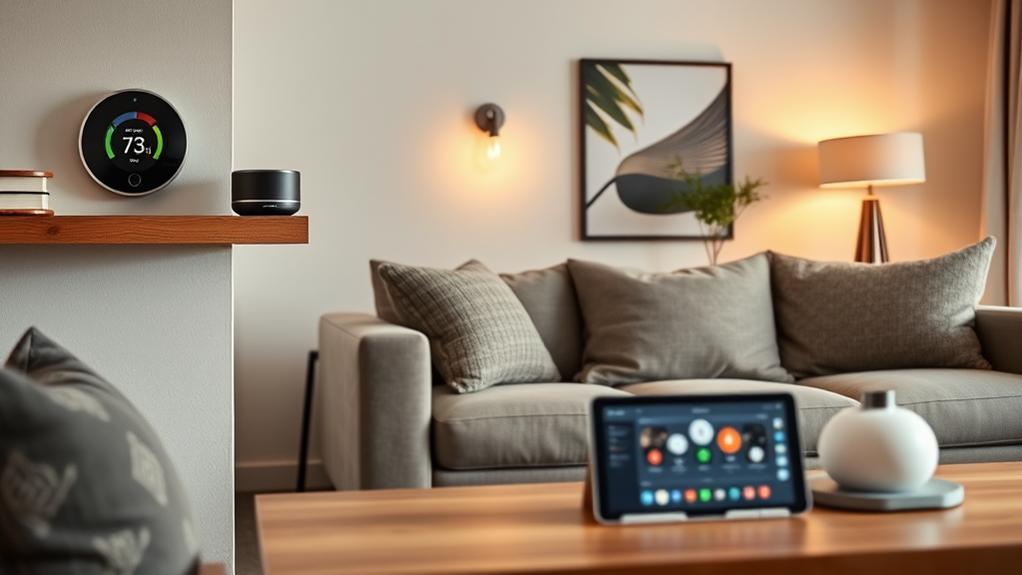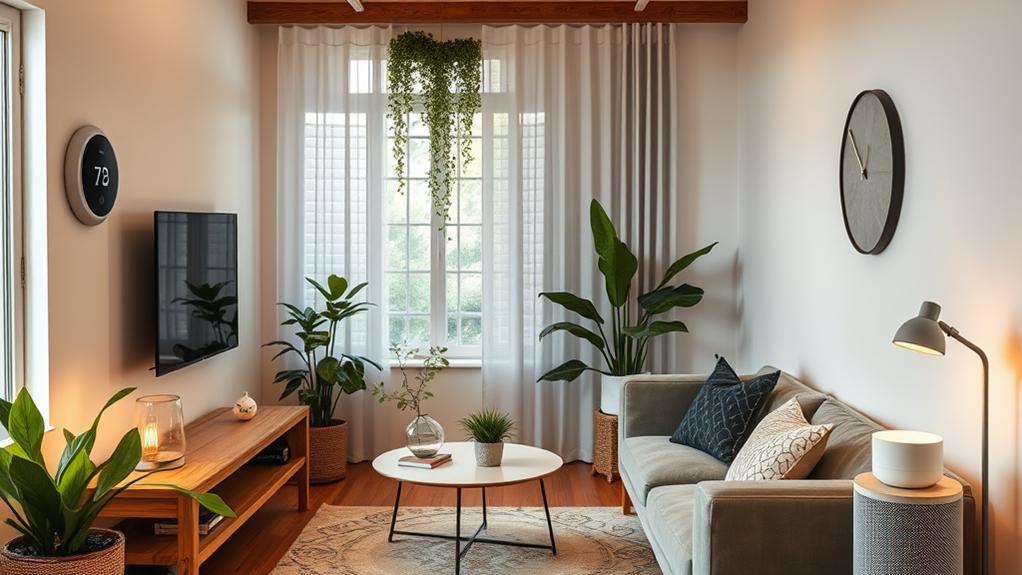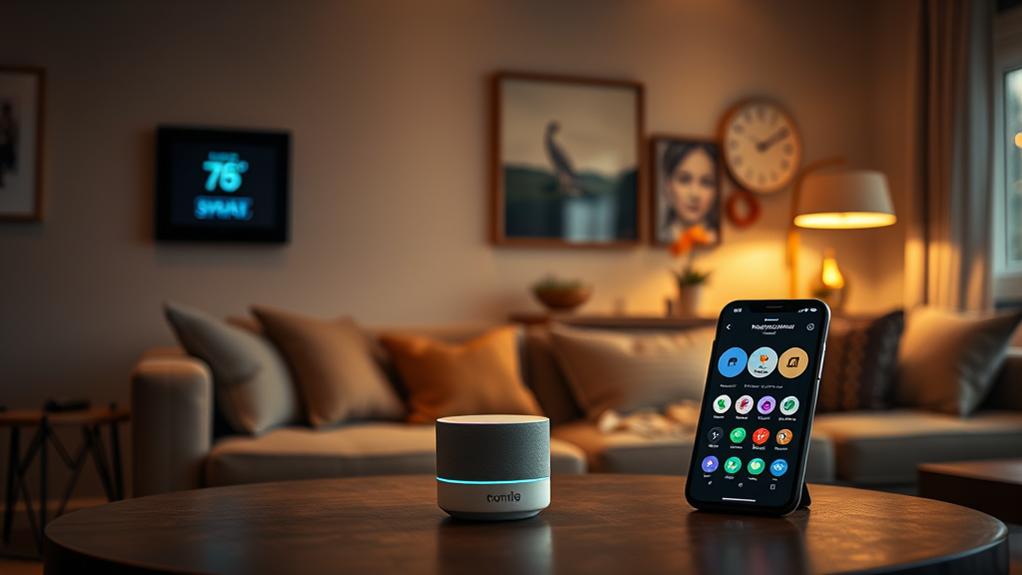When you're setting up your smart home, the network you choose plays an essential role in its effectiveness. You need a reliable router, preferably dual-band or tri-band, placed centrally to maximize Wi-Fi coverage. But that's just the beginning. You'll also want to reflect on adding extenders or a mesh network to eliminate dead zones, and think about how different connectivity options can enhance communication between devices. The security of your network is important too—without it, your smart home could be vulnerable. So, what elements should you prioritize for a truly efficient setup?
Importance of a Stable Network
When setting up your smart home, you can't overlook the importance of a stable network. Your smart devices rely heavily on a consistent internet connection to function properly. If your network is unstable, you'll face issues like lag, dropped connections, and even device malfunctions.
Imagine trying to control your smart thermostat or security camera only to find they're offline due to network problems. Frustrating, right?
A stable network guarantees seamless communication between your devices, allowing them to work in harmony. This means you can enjoy features like remote access, automation, and real-time monitoring without interruptions.
Furthermore, a reliable network enhances the security of your smart home. When your devices are constantly connected, you'll receive timely updates and alerts, keeping your home safer.
Investing time in establishing a robust network infrastructure pays off in the long run. You'll reduce the risk of connectivity issues and enhance your overall smart home experience.
Choosing the Right Router
As you commence on setting up your smart home, selecting the right router is essential for guaranteeing a strong and reliable network. A good router acts as the backbone of your smart home, connecting all your devices seamlessly.
When choosing a router, consider the number of devices you'll connect. If your home is filled with smart gadgets, opt for a dual-band or tri-band router to handle multiple connections without lag.
Next, pay attention to the router's speed. Look for models that offer high throughput, typically measured in Mbps, to accommodate streaming, gaming, and other data-heavy tasks.
Also, check the range of the router. Make sure it can cover your entire home, especially if you have a larger space or multiple floors.
Security features are another critical aspect. A router with WPA3 encryption will help protect your smart devices from potential threats.
Finally, consider ease of use. A user-friendly interface and mobile app can make managing your network a breeze.
Optimal Wi-Fi Coverage
Achieving ideal Wi-Fi coverage is essential for a seamless smart home experience. You want every corner of your home to have strong, reliable internet, making sure all your devices work flawlessly.
Start by placing your router in a central location, minimizing walls and obstacles between the router and your devices. This positioning can greatly enhance signal strength.
Consider the size of your home. If you have a larger space, it might be worth investing in Wi-Fi extenders or mesh network systems. These devices expand your coverage and eliminate dead zones, allowing for consistent connectivity throughout your home.
Don't forget about interference from other electronics. Keep your router away from microwaves, cordless phones, and Bluetooth devices, as they can disrupt your Wi-Fi signal.
Regularly check your network speeds and performance. If you notice slowdowns, it may be time to adjust the router's channels or upgrade your equipment.
Lastly, make certain your network is secure. A strong password helps protect your bandwidth from unauthorized users, maintaining ideal performance.
Device Connectivity Options
Connecting your smart devices effectively is essential for a well-functioning home network. You have several connectivity options to choose from, each with its pros and cons.
The most common way is Wi-Fi, which works well for most devices. It offers flexibility and can connect multiple gadgets simultaneously, but it may suffer from interference and speed reduction as you add more devices.
Another option is Bluetooth, ideal for short-range connections. It's perfect for devices like smart speakers or fitness trackers where high bandwidth isn't necessary. However, Bluetooth has a limited range, so you need to be close to the device for it to work effectively.
Zigbee and Z-Wave are also popular in smart homes. These protocols create a mesh network, allowing devices to communicate with each other efficiently. They consume less power than Wi-Fi, making them suitable for battery-operated devices. However, you'll need a compatible hub to manage these connections.
Ultimately, the best setup for you'll depend on your specific devices and how you plan to use them. Consider a combination of these options to optimize your smart home experience.
Security Measures for Smart Homes
When it comes to securing your smart home, you can't overlook the importance of robust security measures.
With the increasing number of devices connected to your network, it's crucial to protect your personal data and privacy.
Here are three key steps you should take to enhance your smart home security:
- Use Strong Passwords: Create unique, complex passwords for each device and account. Avoid using default passwords, as they're easy targets for hackers. Consider using a password manager to keep track of them.
- Enable Two-Factor Authentication: Whenever possible, turn on two-factor authentication (2FA) for your accounts. This adds an extra layer of security, requiring you to verify your identity through a second method, like a text message or authentication app.
- Regularly Update Firmware: Keep your devices up to date by regularly checking for firmware updates. Manufacturers often release updates to fix security vulnerabilities, so staying current helps protect against potential threats.
Future-Proofing Your Setup
A well-planned smart home setup not only enhances your daily life but also guarantees longevity as technology evolves. To future-proof your setup, start by investing in devices that support the latest standards, like Wi-Fi 6 or Matter. These technologies assure compatibility with future devices and improve overall performance and connectivity.
Next, consider a modular approach to your smart home ecosystem. Choose products from reputable brands that offer regular firmware updates and have a proven track record of longevity. This way, you won't have to replace everything if one device becomes obsolete.
Don't overlook scalability; select a hub or platform that can easily integrate new devices without requiring a complete system overhaul.
Also, think about your network's bandwidth. As you add devices, confirm your router can handle the increased load, possibly by upgrading to a mesh network for better coverage.
Lastly, keep abreast of emerging technologies and trends. Regularly assess your setup to make necessary adjustments or upgrades, assuring your smart home remains cutting-edge and efficient as technology continues to evolve.
Conclusion
In your quest for the perfect smart home network, remember that a strong foundation sets the stage for innovation. By choosing the right router, ensuring ideal coverage, and implementing robust security measures, you'll create a seamless digital ecosystem that thrives. Think of your network as a well-tuned orchestra, where each device plays its part harmoniously. As technology evolves, stay adaptable and keep your setup future-ready, so your smart home can dance gracefully into tomorrow.











